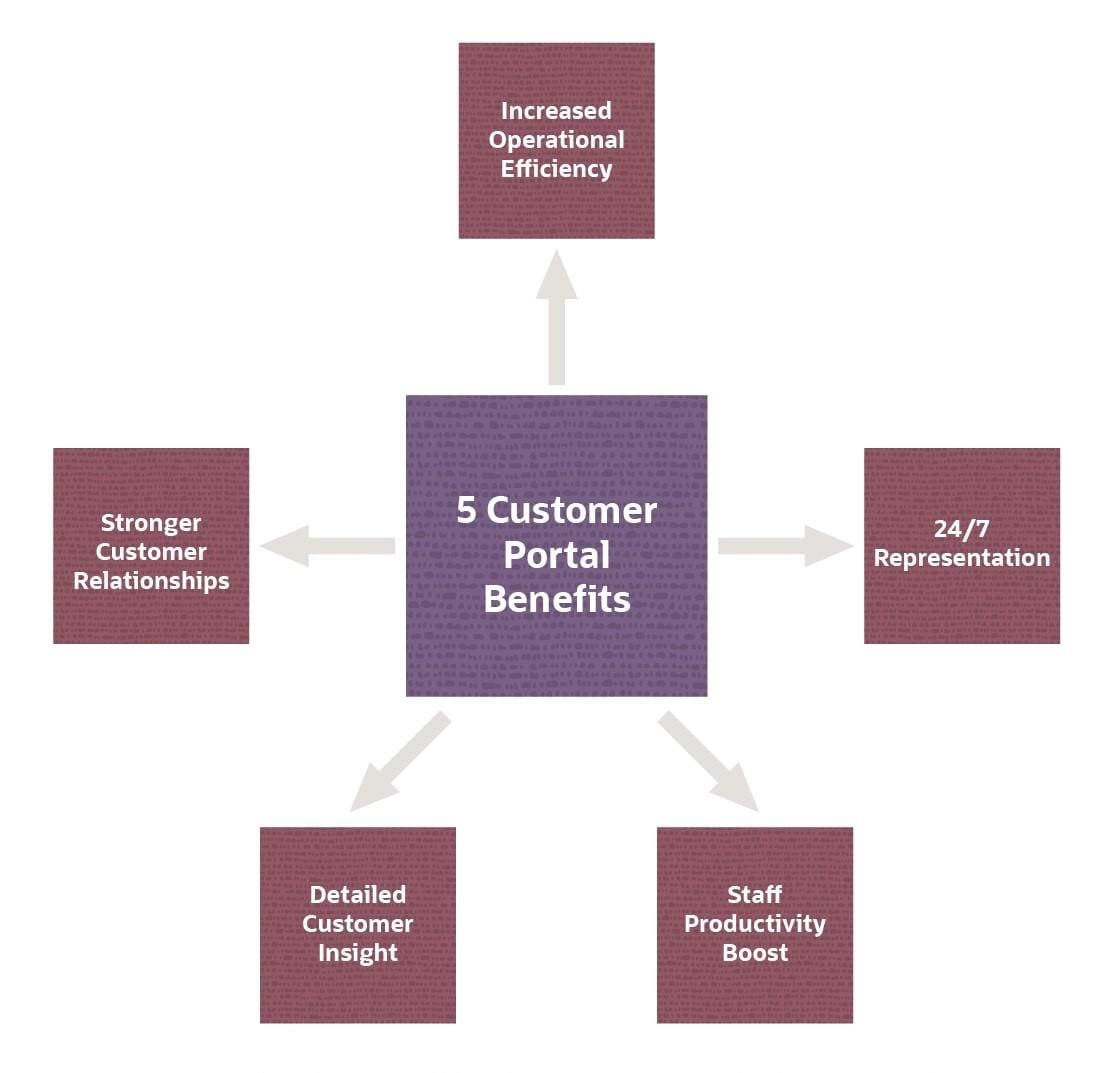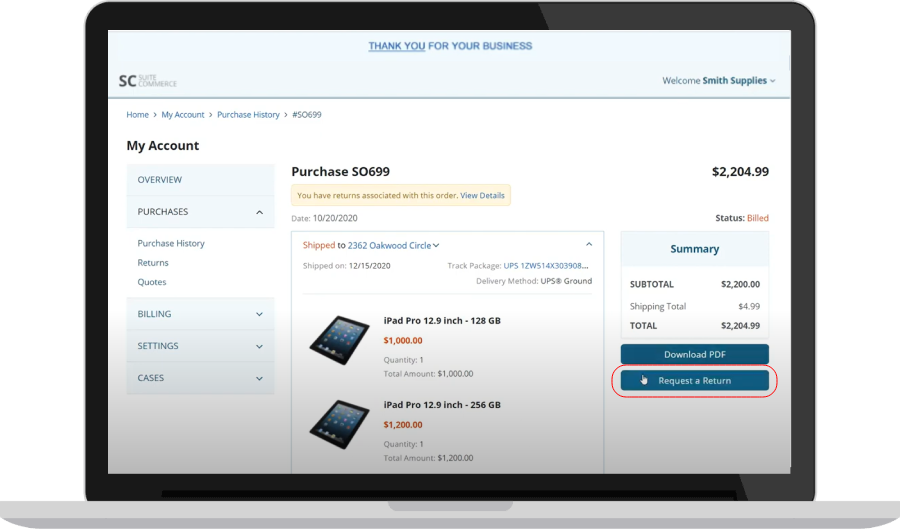Most customers would rather not talk to you. But don’t take offense: In the three decades since the internet became publicly available, customers have grown accustomed to handling their own needs, from answering a question or tracking an order to updating account preferences and more. In fact, most people prefer taking care of tasks independently because it saves them the time and effort of having to contact customer support for every small task.
Successful businesses have answered this call (pun intended) by implementing customer portals chock-full of self-service capabilities and access to myriad resources and information related to the company’s offerings. Not only can these portals improve the customer experience, but, as a result, they also pay off for businesses in terms of long-term customer retention, brand loyalty and lower operational costs.
What Is a Customer Portal?
A customer portal is a secure website or mobile application that companies use to deliver self-service capabilities to their customers — many of whom would rather resolve their own queries than have to reach out to a call center. Research backs this up as a strong customer preference, including one report (opens in a new tab) that found that more than two-thirds of respondents said they preferred self-service over speaking to a company representative, and another (opens in a new tab) report in which 81% of respondents said they wanted businesses to provide them with more self-service options. These options often include the ability for customers to manage their accounts, track orders, pay bills, access product guides and video tutorials, and interact with other customers.
Key Takeaways
- Positive customer service engagements are a key driver of repeat business.
- A customer portal can improve operational efficiencies and yield higher customer satisfaction.
- Customer portals reduce or eliminate the amount of time employees must spend resolving inquiries.
- Through integrations and advanced technologies like artificial intelligence, a customer portal can include very robust and intelligent features.
Customer Portals Explained
A portal, as defined by Gartner, “acts as a value-added middleman by selecting content sources and assembling them in a simple-to-navigate-and-customize interface for presentation to the end user.” A portal can be intended for employees, partners, vendors or customers. A customer portal is a platform that provides a company’s customers with a self-service means of retrieving the information they seek. By providing a central platform for the delivery of customer services, a customer portal can be a strategic element in how a company interacts with its customers.
Make no mistake: The customer services stakes are high. A positive customer experience is now a baseline expectation and competitive differentiator. Keeping customers happy is also smart business. For example, according to Bain & Co. (opens in a new tab), a 5% increase in customer retention in the financial services industry yields more than a 25% increase in profit. That’s because returning customers tend to buy more over time, refer new customers and pay a premium to stick with the business they know, rather than leave for an unfamiliar competitor.
Why Are Customer Portals Important?
Customer portals bring technological innovation to the age-old practice of customer service, improving on the days when people had to call a company to accomplish what they needed to do, be it getting the answer to a simple inquiry, resolving a billing issue or troubleshooting a technical problem. For their part, businesses used to have to make sure they were equipped with sufficient staff to answer calls, send emails and provide other forms of support promptly to resolve support tickets as quickly as possible. Growing businesses, in particular, faced the challenge of scaling quickly enough to support an increasing number of customers and requests, while keeping hold times on calls to a minimum.
These days, customers are increasingly tech-savvy and, with the internet at their fingertips, have grown accustomed to seeking out what they need without assistance. Customer portals enable them to self-serve, leading to feelings of accomplishment and empowerment that keep customers returning. At the same time, portals can boost a company’s productivity level by reducing or eliminating the amount of time employees must spend on resolving inquiries — savings that go right to the business’s bottom line. Customer portals also help companies understand their customers better — why they visit the site, their behaviors, their preferences — which leads them to improving their offerings, thereby creating a virtuous cycle.
Customer Portal Benefits
A customer portal should be thought of as an extension of a company. Though one of the goals of a portal is to help customers help themselves — thereby decreasing the number of live interactions with the company — when done well, it can actually build trust and deepen relationships, despite that lack of human touch. The business benefits of a customer portal include:
- Increased operational efficiency: Customers log into a company’s portal for a host of reasons — to access product-related content, recover a forgotten password or schedule an appointment, to name a few. The more easily customers can find and resolve the issue on their own, the fewer support tickets customer support employees will have to address, saving time and reducing support costs. Additional efficiencies result from customers’ ability to input their information directly, select options from menus and complete tasks independently.
- 24/7 representation: Customer portals don’t follow typical business hours. They can be accessed around the clock, across locations and time zones, and without additional staff. With the assistance of chatbots, companies can provide robust service-service capabilities wherever their customers may be.
- Staff productivity boost: When customers self-serve, staff can devote their time to more complex or urgent issues and strategic initiatives — including making the portal an even better experience. Customer portals can further boost worker productivity by handling some tasks so humans no longer have to. For example, the portal can automatically generate customer invoices, send notifications about orders that have left the warehouse, or provide other forms of “personalized” outreach.
- Detailed customer insight: By tracking customer-portal activity, the company can gain valuable insights about their customers, such as who they are, why they’re there, and their engagement and purchase patterns. For example, a sudden spike in similar queries might indicate that customers are experiencing problems with a recent service upgrade, or it could also shed light on an untapped opportunity. Analysis and reporting of portal information can help the business better tailor its offerings, inform marketing campaigns, improve the user experience and, overall, enable data-driven decision-making that drives growth.
- Stronger customer relationships: “Customer experience” has been a catchphrase for years, and for good reason: Satisfied customers spend more, are more brand loyal and tell others about their great experiences. In fact, the most important aspect of a good customer experience is companies that value customers’ time, according to nearly 66% of respondents surveyed by customer-engagement firm Khoros. For all of the previously stated reasons, self-serve customer portals play a critical role.

Features of Customer Portals
At a bare minimum, a customer portal should allow customers to manage their own basic account information and preferences. But if viewed through the must-see lens of competitive differentiation, a customer portal’s features should by no means stop there. And, it’s also worthwhile to restate: All of the advantages of a portal for customers have equal advantages for businesses, in terms of the benefits described in the previous section.
Top-notch portals should include:
- Security and privacy: The most comprehensive customer portal means little without the proper measures in place to protect customers’ sensitive information. In fact, using the portal could be downright dangerous otherwise. Among the ways businesses can secure their customer portals: using strong authentication methods, such as multifactor authentication, to confirm that customers are who they say they are; encrypting data during transmission and “at rest” so unauthorized parties can’t read it; limiting staff access to and around the portal, based on their roles; and collecting proper consent from customers regarding data collection, sharing and use.
- Personalization: Personalization has become a tried-and-true way of building customer affinity. At its most basic level, the customer portal can greet a person by name, which serves as a subtle reminder that they’re not just an anonymous user in the eyes of the company. Other forms of personalization — as informed by customer portal analytics — include product recommendations, content tailored to the customer’s needs and interests, and tailored promotions.
- Customer forums: Enabling customers to interact with their peers builds community, which is another powerful way to help customers solve their own problems, even as they engage with others. It’s also useful in terms of receiving feedback that can lead to all sorts of improvements — either to the portal itself or even to the business’s product or service. And when customers feel heard and valued, it positively affects their brand loyalty, according to an annual Forrester study about customer experience.
- Chatbots: Chatbots provide real-time responses to frequently asked questions; they can also troubleshoot and resolve technical issues (and otherwise assist customers) without the need for the customer to speak to a live agent. Chatbots also can assist in completing routine tasks, such as processing a payment; can search the portal for requested information; and can retrieve information from other back-end systems (more on that soon).
- Mobile accessibility: According to the World Economic Forum, the number of mobile subscriptions now exceeds the number of people worldwide. That means that a customer portal must be optimized for mobile use, in terms of security and authentication, adaptability to different screen sizes, easy and intuitive navigation, simple layout, clear and readable content, fast page and image loading and performance, and mobile-friendly forms.
- Order management: From order placement and tracking to fulfillment and returns or exchanges, a customer portal provides customers with a centralized hub to independently manage the various steps involved in the purchasing process. The same goes for keeping tabs on a project, such as in manufacturing and construction. The portal should also store an archive of past purchases and projects for easy reference.
- Invoice and payment management: Hand in hand with ease of order management, a customer portal makes it easy for customers to access, review and download their invoices and manage their payment status. Payments can be made directly through the portal, which records the customer’s every transaction and can provide notifications automatically at specific milestones, such as when payment is near due or when a payment has been received.
- Communications: A customer portal offers a direct line of communication between a company and its customers. It supports proactive engagement by having at the ready the documents and functionality, such as a support ticketing system, that customers need to self-serve — which, in turn, improves customer experience. A portal facilitates real-time support by empowering customers to initiate conversations via chatbot and other messaging features. It can also alert customers to timely information that might impact use of their accounts, such as a software update that will halt access for a few hours, and offer ways for them to share their feedback.
- Tech stack integration: Tech stack integration enables seamless communication between the customer portal and other key back-end systems — such as enterprise resource management (ERP), customer relationship management (CRM) and inventory management — in order to take advantage of each of those technologies to offer a multitude of features and capabilities. Importantly, integration ensures that systems are in sync so that customers are accessing consistent, accurate information from a single interface. For example, integration with the inventory management system can automatically update product availability on the portal, while integration with payment gateways lets customers pay their bills at the portal, both of which increase operational efficiencies and customer satisfaction.
How to Decide Whether Your Business Needs a Customer Portal
Businesses of all sizes, across all industries and with any intention of growth stand to benefit from having a customer portal. Generally speaking, the earlier the implementation — i.e., when the business is still small — the more manageable its launch and gradual expansion. Following are a dozen-plus questions to consider when determining whether a customer portal is right for your business.
- How many live customer interactions does your business have now?
- Why are customers calling and how much time does each call take, on average?
- What challenges do customers face in their interactions with you?
- How do you gather and respond to customer feedback?
- How complex or technical is your product or service?
- How much are you selling now, in terms of volume, and what are your projections? Do you plan to expand your product or service line?
- How many employees are currently fielding customer inquiries?
- What does that process look like? For example, how many times does the call get transferred to another agent?
- What would happen if there was a sudden influx of calls?
- Do customers expect you to have a customer portal?
- Do your competitors offer a customer portal?
- From a business standpoint, what would be the return on investment? What resources, infrastructure and expertise are needed for implementation and maintenance?
How to Choose the Right Customer Portal
Like any technology purchase, selecting the right customer portal requires thoughtful planning and vetting. After a thorough assessment of the business’s needs, an understanding of what customers expect and a knowledge of what competitors are offering, decision-makers — with these requirements in hand — should consider the following in their search for a solution:
- User experience: The user interface is the first thing a customer will see when accessing the portal. What does it look like? Is it easy to navigate? Does the design make sense? Is everything clearly labeled? Can the interface be customized and/or personalized?
- Scalability: Create a customer portal that not only meets the business’s needs in the short term but can grow along with the business, in terms of new functionality and the number of customers and staff who can use it simultaneously.
- Integration: Can the customer portal be integrated into your existing (or planned) tech stack, thereby increasing its functionality? For example, if the portal is going to be used for help desk support, will it integrate with the existing ticketing system?
- Data security and privacy: By its very nature, the customer portal will be brimming with sensitive customer data — bank account details, legal documents, tax information, medical records, etc. — so security and privacy can’t be overlooked. Data encryption and airtight authentication to access the portal are key features.
- Mobile design: Today more than half of all website traffic comes from mobile devices, according to multiple sources. Be sure to review each vendor’s mobile version of its customer portal solution, as the limited screen size will affect user experience. Does the portal respond and adapt to different screen sizes, orientation and resolutions across smartphones, tablets and laptops? Do images load quickly?
- TCO and ROI: Assess the customer portal’s total cost of ownership (TCO). The evaluation should include total up-front costs, licensing fees, implementations costs, ongoing maintenance and support fees. Then calculate the potential cost savings derived from more efficient operational processes and reduced manual effort, as well as happier customers who could very well buy more, to gauge the return on investment (ROI).
- Vendor support: Review each vendor’s service-level agreement to ascertain guaranteed response and resolution times, particularly in the event of a critical issue or disruption. Is the vendor available 24/7? Through which channels? Even more important, how much industry and technical experience do they have? Do they provide ongoing training? Be sure to also understand how each vendor handles software updates — are they delivered from the cloud or on premises?
Future of Customer Portals
The future of customer portals is very much tied to advancements in adjacent technologies that make life easier for customers and businesses alike. Already, artificial intelligence (AI) and machine learning (ML) are gaining footholds by supercharging chatbots and virtual assistants, enhancing personalized experiences, powering voice recognition, analyzing customer data to predict trends, detecting fraud and plenty more. Knowledge bases, too, could be improved by AI and ML: When customers query a chatbot, for example, the technologies are not only able to answer their questions, but they can also automatically update and improve existing articles and documentation.
In addition, a portal’s integration with Internet of Things devices, such as those used in manufacturing plants and warehouses to track production and product whereabouts, also helps to ensure that customers are provided with the most accurate information in real or near-real time. And as cloud computing continues to gain traction among businesses of all sizes — for example, 53% of small and midsize businesses surveyed by Flexera spent over $1.2 billion on the public cloud in 2022, up from 38% in 2021 — its scalability, cost-effectiveness and accessibility won’t be lost on companies of all sizes and industries that are deciding how to deploy their customer portals.
Expand Customer Self-Service With NetSuite
Improving the customer experience while reducing operational costs are just a click away with NetSuite SuiteCommerce MyAccount. This self-service customer-portal solution provides your customers with easy access to manage their accounts online. It also reduces the number of support staff necessary by providing self-service resources, removes steps in the billing process to hasten payment, and shortens the path from quote to sale. In addition, SuiteCommerce MyAccount provides drag-and-drop tools for managing content, such as how-to guides and frequently asked questions, and allows customers to manage their subscriptions. The more your customers can do on their own, the happier they will be and the more likely they will become loyal to your business. That’s good news for your bottom line.

As part of NetSuite’s commerce solutions, SuiteCommerce MyAccount integrates seamlessly with other NetSuite solutions, such as the inventory management, order management and CRM modules that are part of NetSuite ERP. And through the NetSuite Connector, SuiteCommerce MyAccount can also be connected to ecommerce storefronts, online marketplaces and other third-party utilities.
A little empowerment can go a long way. By providing customers with the resources and functionality to answer their own questions without requiring the assistance of live support, customer portals help them build long-term affinity with a company, which also benefits from significant operational efficiencies and savings. In addition, analyzing how customers use the portal can help a business better understand who their customers are and what they want, all of which can inform a wide breadth of decision-making.
Customer Portal FAQs
What is the use of a customer portal?
Customer portals provide a secure way for companies to connect with their customers and enable them to self-serve. Customers use these portals to manage their accounts, retrieve and pay invoices, track orders, access technical support and documentation, and much more.
What should be in a customer portal?
The contents of a customer portal vary depending on the nature of the business, of course, but common elements include frequently asked questions, knowledge base articles, video tutorials and troubleshooting guides. They typically allow customers to manage their accounts, submit support tickets and track shipments, among other capabilities.
What is a customer portal in CRM?
A customer portal is often integrated with a customer relationship management (CRM) system, which manages customer interactions with a business and is typically used by the sales and customer service departments.
How do you create a customer portal?
Creating a customer portal from scratch is a complex undertaking best left to the expertise and experience of the right vendor. Conducting a thorough assessment of your business’s objectives and requirements is an important first step before reaching out to vendors.








